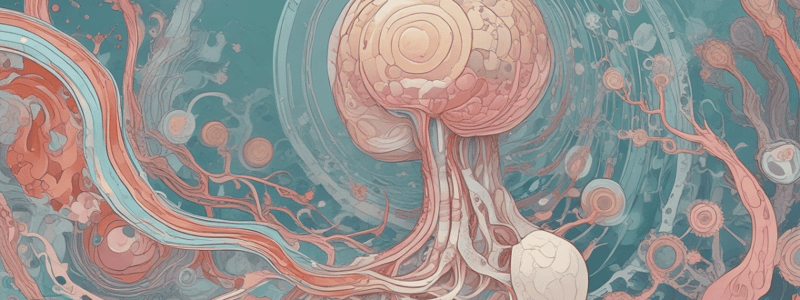Podcast
Questions and Answers
What is the outer glycoprotein coat of an egg cell called?
What is the outer glycoprotein coat of an egg cell called?
What is the term used to describe the process of cell division without growth during early embryogenesis?
What is the term used to describe the process of cell division without growth during early embryogenesis?
What is the term used to describe the stage of development when the embryo has divided into 16-32 cells and looks like a mulberry?
What is the term used to describe the stage of development when the embryo has divided into 16-32 cells and looks like a mulberry?
What happens to the cells during the cleavage stage of early embryogenesis?
What happens to the cells during the cleavage stage of early embryogenesis?
Signup and view all the answers
What is the process called when the cells of the embryo compact and become tightly packed together?
What is the process called when the cells of the embryo compact and become tightly packed together?
Signup and view all the answers
How many cells does the embryo have at the end of the cleavage stage?
How many cells does the embryo have at the end of the cleavage stage?
Signup and view all the answers
What is the term used to describe the fertilized egg cell that has not yet started dividing?
What is the term used to describe the fertilized egg cell that has not yet started dividing?
Signup and view all the answers
What structure do the cells of the embryo remain within during the cleavage stage?
What structure do the cells of the embryo remain within during the cleavage stage?
Signup and view all the answers
What is the process called when cells become different from each other?
What is the process called when cells become different from each other?
Signup and view all the answers
What is the outer layer of cells called in the morula?
What is the outer layer of cells called in the morula?
Signup and view all the answers
What is the cavity formed in the blastocyst?
What is the cavity formed in the blastocyst?
Signup and view all the answers
What is the process called when the zona pellucida disintegrates?
What is the process called when the zona pellucida disintegrates?
Signup and view all the answers
What is the term for the inner cell mass of embryoblasts?
What is the term for the inner cell mass of embryoblasts?
Signup and view all the answers
What is the name of the structure formed by the epiblasts and hypoblasts?
What is the name of the structure formed by the epiblasts and hypoblasts?
Signup and view all the answers
What is the name of the stage of early embryogenesis that marks the formation of the three germ layers?
What is the name of the stage of early embryogenesis that marks the formation of the three germ layers?
Signup and view all the answers
What is the term for the cells in the layer on the bottom of the inner cell mass?
What is the term for the cells in the layer on the bottom of the inner cell mass?
Signup and view all the answers
What is the next stage in development after the blastocyst?
What is the next stage in development after the blastocyst?
Signup and view all the answers
What is the name of the structure that forms in the middle of the mesoderm during neurolation?
What is the name of the structure that forms in the middle of the mesoderm during neurolation?
Signup and view all the answers
What is the shape of the blastocyst?
What is the shape of the blastocyst?
Signup and view all the answers
What is the name of the layer of cells that forms on the top of the trilaminar disk?
What is the name of the layer of cells that forms on the top of the trilaminar disk?
Signup and view all the answers
What is the term for the process of forming a blastocyst?
What is the term for the process of forming a blastocyst?
Signup and view all the answers
What is the purpose of the notochord in humans?
What is the purpose of the notochord in humans?
Signup and view all the answers
What is the name of the stage of early embryogenesis that follows gastrulation?
What is the name of the stage of early embryogenesis that follows gastrulation?
Signup and view all the answers
What is the term for the initial structure that forms from the fertilized egg?
What is the term for the initial structure that forms from the fertilized egg?
Signup and view all the answers
What is the result of the formation of the primitive streak?
What is the result of the formation of the primitive streak?
Signup and view all the answers
What is the name of the layer of cells that forms on the bottom of the trilaminar disk?
What is the name of the layer of cells that forms on the bottom of the trilaminar disk?
Signup and view all the answers
What is the term for the process by which the cells in the epiblast layer migrate to form the primitive streak?
What is the term for the process by which the cells in the epiblast layer migrate to form the primitive streak?
Signup and view all the answers
What is the name of the thickening in the ectoderm?
What is the name of the thickening in the ectoderm?
Signup and view all the answers
What is the structure formed by the neural plate cells as they dive into the mesoderm?
What is the structure formed by the neural plate cells as they dive into the mesoderm?
Signup and view all the answers
What is the name of the cells that break off from the ectoderm and go into the mesoderm during neural tube formation?
What is the name of the cells that break off from the ectoderm and go into the mesoderm during neural tube formation?
Signup and view all the answers
What is the term for the early stage of development where the zygote splits into a bunch of cells?
What is the term for the early stage of development where the zygote splits into a bunch of cells?
Signup and view all the answers
What is the structure that forms a cavity after the blastocyst cavity forms?
What is the structure that forms a cavity after the blastocyst cavity forms?
Signup and view all the answers
What is the term for the process of neural plate forming, diving into the mesoderm, and forming the neural tube?
What is the term for the process of neural plate forming, diving into the mesoderm, and forming the neural tube?
Signup and view all the answers
What is the name of the cells that form on the outside of the blastocyst?
What is the name of the cells that form on the outside of the blastocyst?
Signup and view all the answers
What is the term for the process of cells in the morula differentiating into two groups?
What is the term for the process of cells in the morula differentiating into two groups?
Signup and view all the answers
Study Notes
Early Embryogenesis
- The process begins with a zygote, a single cell formed after fertilization by a sperm.
- The zygote has a thick outer glycoprotein coat called the zona pellucida and a plasma membrane.
Cleavage Stage
- The zygote undergoes rapid cell division without growth, resulting in multiple cells within the zona pellucida.
- This process is called cleavage, and it forms a morula, a compact cluster of cells resembling a mulberry.
Compaction and Differentiation
- Morula cells start to differentiate and compact, with cells on the outside becoming trophoblasts and cells on the inside becoming embryoblasts.
- This process is called differentiation, where cells become distinct and acquire specific functions.
Blastulation Stage
- The morula undergoes further differentiation, forming a blastocoel (cavity) and a cluster of cells called the inner cell mass (embryoblasts).
- The zona pellucida disintegrates, and the structure is now called a blastocyst.
- The process is called blastulation, characterized by rapid cell division and differentiation.
Formation of Amniotic Cavity and Bilaminar Disk
- The blastocyst forms an amniotic cavity, and the inner cell mass differentiates into two layers: hypoblasts and epiblasts.
- These layers form a bilaminar disk, a critical structure in embryology.
Formation of Primitive Streak and Gastrulation
- The epiblast layer develops a primitive streak, a site where cells migrate and differentiate.
- Cells from the epiblast layer migrate and burrow into the hypoblast layer, forming a trilaminar disk with three germ layers: ectoderm, mesoderm, and endoderm.
- This process is called gastrulation, marking a significant milestone in early embryogenesis.
Neurolation Stage
- The trilaminar disk undergoes further differentiation, forming a notochord (a mesodermal structure) and a neural plate (an ectodermal structure).
- The neural plate thickens and forms a neural tube, which eventually gives rise to the nervous system.
- Neural crest cells, breaking off from the ectoderm, will differentiate into various tissues.
- The formation of the neural tube and neural crest cells marks the completion of early embryogenesis.
Studying That Suits You
Use AI to generate personalized quizzes and flashcards to suit your learning preferences.
Description
Learn about the process of early embryogenesis, from the moment a sperm fertilizes an egg cell to the formation of an embryo. Understand the role of the zona pellucida and plasma membrane in this crucial stage of development.




